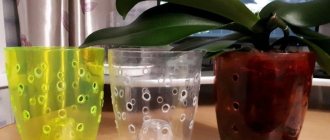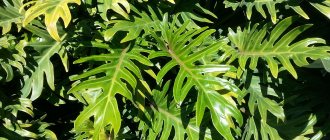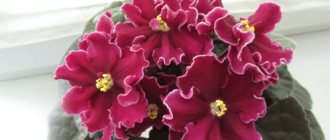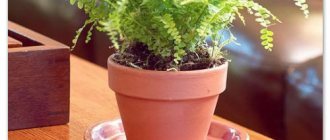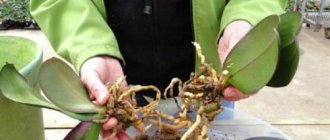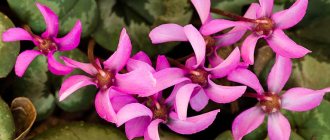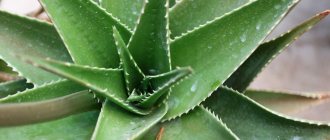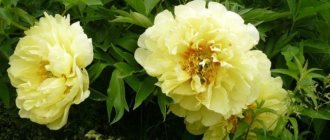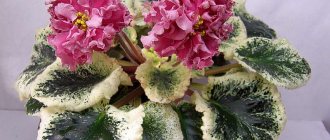There are some plants that immediately attract attention. In any flower arrangements, they have a solo part prepared in advance. Schefflera is exactly such a plant. Her strength lies not only in her striking beauty, but also in her special energy..
It absorbs negativity from the environment, helps you relax and unwind. It also purifies the air. An unpretentious plant is a welcome guest in any home . But what is this flower and how does it reproduce at home?
general information
The most characteristic feature of Schefflera (pictured) is its unusual leaves. They have a finger-complex structure. Each leaf consists of several lobes.
They can be oval or pointed. Externally they resemble fingers . Each slice meets the others in the center. The presence of thin petioles makes the leaf look like a smaller copy of an umbrella.
The height of shefflera in its natural environment reaches from 4 to 6 m, and the lush crown in volume reaches 1.5 m. A miracle of nature is budding . Paniculate peduncles are painted in various shades. Later, berries appear in their place. Seeds are obtained from them. In indoor conditions, the formation of flowers is a very rare occurrence.
Possible problems
When growing sheflera, gardeners may encounter some problems. Often, if grown and cared for improperly, the flower is attacked by pests:
- Spider mite. The plant is covered with a thin web. White-yellow blotches are visible on the leaf. To destroy the pest, the leaves are washed with soapy water, and then the preparations Actellik and Fitoverm are used.
- Greenhouse aphid. The insect is dangerous because it sucks the juice from the plant. The leaves turn orange, then curl and fall off. The drugs Actellik and Fufanon are used against aphids.
As a preventive measure, the leaves can be wiped with soapy water and the flower can be given a warm shower.
If planted and cared for incorrectly, the flower may encounter the following problems:
- Powdery mildew. The leaf blade is covered with a white powder-like coating. If you look closely, you can see small ulcers from which fluid is released. The leaves begin to wither, dry out and fall off. You can get rid of powdery mildew using systemic fungicides.
- Rust. This disease affects stems and leaves. A sign of the disease is clusters of orange or brown spores on the underside of the plate, yellow oval or round spots on the top. Then the spots turn into brown stripes and the leaves fall off. Eliminate the disease with chemicals: Topaz, Abiga-Pik, Baktofit.
- Gray rot. The main reason for the appearance is the presence of the flower in a cold, damp room. The disease can be detected by a gray coating on the leaf. Infected leaves are removed, and the plant itself is treated with chemicals such as Fundazol.
- Bacterial spotting. Watery, glassy spots appear on the undersides of the leaves and turn dark brown over time. It is impossible to cure the plant; it should be disposed of along with the soil, and the pot should be disinfected.
Falling leaves
It happens that the leaves turn yellow and the plant begins to shed its foliage en masse. Why do Schefflera leaves fall? This is often due to dry indoor air.
If a problem is detected, you need to check the soil in the pot, it should be moist. Drying out the soil slows down the growth of the leaf blade, it weakens and falls off. The fall of variegated foliage can be caused by a lack of light. Too wet soil can also cause leaf shedding.
Blackening of leaves
When the root rots, the leaves of the flower begin to turn black. This happens when you water too often.
Black leaves on Schefflera
The flower is removed from the pot and the damaged roots are carefully removed. Afterwards they need to be sprinkled with crushed coal and dried.
Important! If the bush is exposed to a draft for a long time, it can catch a cold. The leaves turn black and fall off. The leaf blade becomes covered with spots after exposure to sunlight. Yellow leaves indicate the presence of pests.
If you adhere to the rules of care and planting, you can easily grow sheflera at home. It is believed that even a novice lover of indoor flowers can cope with this.
Schefflera: description and origin, photo
This beauty represents the Araliev family. The most popular varieties are wood shefflera. Its habitat is tropical forests in Southeast Asia.
These plants are also very common in Indonesia and the Malay Archipelago . There are about 200 species of Schefflera in the wild, but there are no more than a dozen ornamental species.
Four types are best suited for indoor floriculture:
- Palmate. The oval-shaped leaves consist of 7–10 elongated “fingers” with long petioles. There are bright veins. The bush itself is quite compact.
- Radifolia. This species is also called star-shaped. It is distinguished by large leaves (about 15 cm long). They have a rich green tint.
- Tree-like. Its characteristic feature is the complex structure of the leaves. They are glossy and quite dense. The bush reaches 1.2 meters in length. There are both green and variegated varieties.
- Eight-leaved. A very rare species. But it has already gained popularity among flower growers. The leaf length reaches 30 cm, and the width is about 10 cm. The surface is decorated with light veins.
This video shows some types of Schefflera and gives recommendations for caring for the plant.
Propagation by seeds
The variegated houseplant does not bloom. Then how to propagate sheflera from seeds? Answer: buy planting material in the store. In its natural environment, it decorates itself with flowers in which a seed is formed. Before planting, it is soaked in a nutrient solution.
- To sow seeds, take deep boxes.
- The bottom is covered with any drainage material.
- Soil is poured on top 20-30 cm.
- At a distance of 15 cm from each other, holes with a depth of 10-15 cm are made with a pencil. The seeds are lowered into them.
- Boxes with seedlings are covered with polyethylene (glass) and placed in a warm, shaded place.
- Periodically carry out simple maintenance: open the film, water the soil. When seedlings appear, spraying is carried out. After the formation of 2-3 leaves, they are planted in pots.
This method of propagating sheflera is labor-intensive and is suitable for large-scale production of variegated crops.
Schefflera: propagation at home
Like many other plants, Schefflera can be propagated by two methods: vegetative and generative.
Seeds
Planting material can be easily purchased at the store. It is almost impossible to obtain seeds yourself . They are planted in January or February. By the arrival of calendar spring, the plant obtained from seeds will have time to grow stronger and adapt to environmental conditions.
Advice! They are first kept in warm water or epin solution (no longer than a day). Then they take wide containers with high walls and fill them with fertile and light soil. Boxes are quite suitable for these purposes. The seeds are buried approximately 5 mm.
After this, the soil is moistened and the containers are sealed with film. Having an improvised greenhouse is mandatory .
Caring for seedlings is simple. It is enough to put them in a bright place, regularly ventilate them and spray them with warm water from a small spray bottle. Sprouts with a pair of clear leaves can be picked.
Instructions for propagation by cuttings
Cuttings are carried out most often. There are two ways to achieve the appearance of roots on the stems: by placing them in a container with water or directly in the soil.
Cuttings in water
For this method it is better to use root cuttings . A transparent jar or any other container is filled with water. Then the plant is placed.
Note! To prevent rotting, it is useful to add charcoal or activated carbon; root can also be used.
The cutting that has already begun to become lignified and has several rosettes of leaves will take root faster. You will have to wait about three weeks . When the roots grow a couple of centimeters, you can transplant the schefflera into the ground.
Rooting cuttings with leaves in the ground
They are harvested in the spring or at the very beginning of summer. The optimal length of the cutting is from 5 to 10 cm. Before taking the shoot, the instrument must be disinfected. The cut site must be treated with special preparations . You can choose from succinic acid, heteroauxin or root.
Advice! The best substrate for rooting is nutritious soil or wet sand. Drainage is very important. Pots with cuttings are covered with a cap made of a regular plastic bag.
Now it is necessary to ensure a constant temperature within + 21–24 degrees. Periodically, the plant requires access to fresh air.
Leaf propagation technology
It can be difficult to achieve a positive result when rooting by leaf. It doesn't always take root . A medium-sized plate must be carefully separated from an adult plant along with the growth zone. It is a growth located between the base of the leaf and the stem.
Add growth stimulants to the settled water and place planting material in them. It's better to take several. Now the vessel needs to be wrapped in film and left warm.
Important! With the appearance of roots, it is time to move the leaf into a preheated substrate. Maintain greenhouse conditions. After a while, begin to ventilate the plantings and introduce moisture into the ground.
Air layering
Propagation of shefflera from an adult flower is the simplest. The mother plant must be mature and absolutely healthy. A cut is made on the non-main stem . They wrap it around it successively with moss, cotton wool and film.
Layers of moss and cotton wool are regularly moistened. The process of roots appearing will take approximately 1.5 months. The resulting air layering must be separated along with the stem. Next they are placed in a pot with suitable soil .
This video shows how to propagate Schefflera from cuttings.
Transplantation with cuttings and seeds
Propagation by cuttings is the easiest option for gardeners. Flower growers use semi-lignified elements cut in the spring. The stalk is cut with a knife or scalpel. To do this, you need to hold the barrel and carefully deepen the blade, but under no circumstances break off the barrel. At the same time, you should not saw it too actively.
So, how does a plant reproduce in stages? The florist should work with gloves and a protective mask if a person is prone to allergies or suffers from asthma, since sheflera has a pronounced, pungent odor. For propagation at home, it is better to select well-developed cuttings, and before planting in the ground, keep the sprouts in a heteroauxin solution overnight. Cuts should be treated with a root formation stimulator or crushed activated carbon. This way, it will be easier to cope with further planting.
There are 2 methods of rooting: using water or substrate. To root sheflera in water, after about a month (for variegated varieties this needs to be done later), plant the cuttings in the ground and cover them with a bag, having previously made holes in it for ventilation (can be replaced with a glass jar). Every day you need to remove the bag for half an hour so that the plant has access to fresh air.
Substrates may be different. The most common are soil and sand (necessarily coarse-grained). With this method, the bag is put on immediately, but otherwise the rooting procedure is the same as in the case of water.
Additionally, drainage material (pieces of brick) is added to the bottom of the pot. The container is filled, leaving a few centimeters to the top, and the cuttings are planted in the ground. After this procedure, the seedling is placed on a well-lit windowsill, trying to maintain an optimal temperature of up to 23º C. Sometimes it will be necessary to ventilate the plant, gradually increasing the time and frequency.
A longer process is planting sheflera using seeds, which can only be purchased, since it is impossible to obtain them yourself. It is optimal to plant them at home in winter; in extreme cases, this should be done before the end of March. The soil should be loose and allow the plant access to oxygen and moisture. For beginners, it is good to use ready-made purchased soil, and for more experienced gardeners, peat and sand. Before planting, the seeds are kept in a zircon solution.
The seed should be planted to a depth of 0.5 cm, then watered, covered with film, and placed in a warm place. Once a day, remove the film for ventilation. After about a month, when the seedlings appear, the seedlings are transferred to a well-lit place, and if possible, lower the temperature to 15º C. During the heat, be sure to spray the growing plant with a spray bottle.
General rules of care
The plant will need intense indirect light. On summer days, the flower is taken outside , shading it from the scorching sun. For decorative species, proper lighting plays a special role.
Important! In winter, shefflera is kept at +13–16 degrees (but not lower than +12), and in summer a temperature of +18 to +22 degrees is considered normal. If it rises higher, growth slows down.
The plant is contraindicated in the proximity of heating devices, air conditioners, as well as drafts. It is necessary to maintain high air humidity by spraying. Fertilizers begin to be applied in the spring and are done until the last days of July (approximately every 2-4 weeks).
Brief information for the amateur gardener
Decorative foliage sheflera is a long-lived plant with graceful dark green shiny leaves collected in rosette umbrellas. The flower slightly resembles a compact palm tree and brings an exotic atmosphere to the apartment.
Sheflera comes from the subtropics; she prefers abundant watering in spring and summer ; with the onset of cold weather, the amount of moisture in the soil must be reduced. For successful development and beautiful appearance, the flower needs feeding with complex liquid fertilizers . The plant needs to be fed in the warm season, once every 2 weeks.
At home, the plant does not bloom , but its leaves remain beautiful all year round, without turning yellow or falling off. For good health and active growth, sheflera requires a not too hot room without drafts, diffused bright light and frequent spraying of the leaves.
PAY ATTENTION to three more bushy plants: Skimmia, Leptospermum and Broom. They can also become a decoration for your home or garden.
Choosing a pot
When transplanting, a new container should be taken a couple of centimeters larger than the previous one. In the case of adult specimens - by 5–6 cm. It is better if the pot is in the shape of a trapezoid or tulip . You can place several plants in one container.
Plant such a flower in your apartment, and it will not only decorate any interior, but will also become a kind of talisman for its owner: it will help open new horizons and bring good luck.
This video shows how to properly transplant Schefflera.
Transplanting a plant
Sheflera grows quickly and increases by 0.3 m every year. Therefore, it is recommended to replant it. But it needs to be moved to new containers every two years, but not more often.
At this time, the flowers will slow down. For normal formation, the plant needs a lot of space, and replanting is necessary in large pots. This procedure is carried out in spring or autumn.
Sequence of work:
- Expanded clay or other drainage is placed at the bottom. This is necessary so that excess moisture is absorbed.
- The soil is distributed over the pot and covered evenly.
- The plant is removed through a pot along with the soil and transferred to another pot.
- Sprinkle the soil, then compact the layer of soil.
- Water the ground well.
There is no need to carefully care for the plant, ordinary actions are enough:
- Watering should be done once every two days. It's enough.
- Maintain the temperature from 20 to 24 0C.
- Apply organic fertilizers containing nitrogen and potassium.
The plant is easy to grow, even if you are a beginner gardener. The bush can be grown, watered, replanted, fertilized and gain invaluable experience.
Schefflera diseases and their treatment
Below we will consider the most common ailments that affect the chef:
- Shchitovka
- Spider mite
- Thrips
Schefflera diseases and their treatment:
- Please note that such a plant must be taken to a separate room and placed away from other plants so that they do not become infected.
- It is necessary to dilute laundry soap in water and apply it to the roots and stems using a spray bottle. Using a cloth soaked in soapy water, you need to remove scale insects and spider mites.
- If this does not help and the plant is completely covered with pests, it is necessary to spray with Karbofos. Repeated treatment should be carried out after 2-3 weeks.
- With excess moisture, it is possible not only for the leaves to darken at the ends, but also for the roots to rot. In this case, replanting with removal of the affected roots will help. It is necessary to wash the roots under running water and cut off the damaged areas with sharp scissors.
The soil that was used to plant sheflera must be thrown away. It cannot be reused; it contains mold spores and pathogenic microorganisms that grow as the roots rot. A new substrate must be used. If it is not there, you can calcine the existing soil in the oven for 2 hours. You can treat the soil with karbofos.
Scheffler
Schefflera leaves are turning yellow, what should I do?
The crop needs feeding, every week, starting in spring. It is worth alternating fertilizing, one week adding nitrogen and complex preparations for indoor crops, and the next time adding organic ones. In winter, the flower does not need fertilizer. During this period, the amount of moisture is reduced and fertilizers are not applied. It is recommended to reduce the temperature to give the culture rest.
Each owner of a houseplant independently decides when to fertilize and prune. Experts recommend trimming the top. After it, side leaves and branches will begin to grow. The plant will become more lush and voluminous. Leaves cut from the top can be placed in water and rooted. This will allow you to grow additional seedlings. By the condition of the leaves you can determine what the flower is missing.
Schefflera leaves turn yellow, what to do:
- If they darken at the tips, the crop does not have enough fertilizer.
- If the leaves dry out at the tips, it means the plant does not have enough moisture.
- If darkening is observed at the tips, stop watering. This indicates an excess of moisture.
- Yellowing of the crown indicates a deficiency of minerals and stagnation of moisture.
Fruit
Schefflera care pruning reproduction. How to properly form the crown of a shefflera?
Crown formation is a very important point in the process of growing shefflera. This allows you to give the plant a more aesthetic appearance, stock up on propagation material and maintain the health of the tree. In addition to pruning, you need to periodically pinch out the branches and follow the rules for subsequent care of this southern plant.
Purpose
Many novice gardeners often neglect pruning plants, but in vain. This procedure not only makes it possible to give the bush the desired shape, but also protects it from disease. Schefflera, despite its unpretentiousness, especially needs the timely removal of excess shoots.
Shefflera trimming can be of two types:
- direct formation of the crown - for greater splendor and density of the plant;
- removal of weak, yellowed, dried out, diseased branches.
In order for the plant to begin to branch, you need to cut off the top. Then you will get a lush tree with a dense crown. If you want to form a bush, you need to cut the trunk itself above the bud that has not yet awakened. In this case, the plant will begin to throw out branches throughout the trunk.
In addition, it is necessary to regularly pinch the bush to regulate the length of the lateral shoots.
It is important to choose the right time for such operations. During the dormant period, in winter, the plant does not need to be touched. This will not only not give the desired result, but may also negatively affect the health of the tree. It is best to wait until spring (March–April), when the plant wakes up and all processes are restored.
Pruning is not just a whim of a gardener who is passionate about his business. This is a necessary operation that must be performed regularly. It performs the following functions:
- allows you to give the plant the desired shape depending on the wishes of the owner;
- promotes the growth of young branches;
- makes it possible to obtain propagation material without harm to the tree itself;
- helps remove damaged or diseased shoots after hibernation.
It is important not to overdo it and not to cut off too much, otherwise, instead of being completely beneficial, the operation may cause harm to the plant. Too long shoots are usually cut off by one third. This is enough to give shape and achieve the desired result.
In addition, pruning a plant, in particular, schefflera, requires compliance with certain rules in order for the process to be the least painful and bring maximum benefit. There are several factors that go into these rules.
- Compliance with the timing of the operation. It is carried out in early spring before the growing season begins.
- The first pruning is carried out after the plant has grown and is more or less formed, strengthened, and accustomed to the conditions. For the first time, 3-4 internodes are cut off on a branch.
- Under no circumstances should you use scissors - only good quality and sharp pruning shears.
- The cuts must be treated with an antiseptic (activated carbon works well), but if the branches are thick, the cut area will need to be covered.
- An adult plant can be cut off at the root (if necessary) - it will not die, on the contrary, it will produce young shoots and grow back.
- To provoke the growth of side shoots to form a round crown, you need to cut the top of the plant into 6-7 internodes.
- To ensure even branching, you need to pinch the ends of the branches.
- After winter it is necessary to carry out sanitary pruning.
